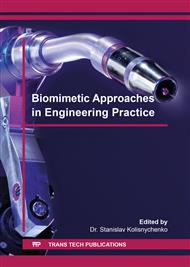p.1377
p.1381
p.1385
p.1389
p.1393
p.1399
p.1404
p.1408
p.1412
Fabrication of Bionic Silicon Surfaces with Lotus Effect and their Micro Tribological Performance
Abstract:
With the miniature of micro-electromechanical systems (MEMS), surface effect is substantially increased, and the resulting friction, abrasion and stiction are becoming bottlenecks of the development of MEMS industry. In this paper, firstly, the feature size and topography on lotus leaf surfaces is investigated, as well as the mechanism of lotus effect applied in MEMS to reduce friction and prevent stiction is analyzed; secondly, two approaches of fabricating bionic silicon surfaces with lotus effect are proposed; finally, test results on the micro tribological performance of the mimicked silicon surfaces are presented, which demonstrates that to mimic lotus effect on silicon surfaces is a novel approach to prevent stiction and reduce friction . However, the effectiveness of stiction prevention and friction reduction is related to the size and shape of the textured structures.
Info:
Periodical:
Pages:
1393-1398
Citation:
Online since:
March 2010
Authors:
Price:
Сopyright:
© 2010 Trans Tech Publications Ltd. All Rights Reserved
Share:
Citation:



